On Friday, January 27, Annie and I drove up to British Columbia to see the Snowy Owls at Boundary Bay.
It was not a long trip for us. Bellingham is just 37 km (22 miles) from the border.
US-Canadian Border
We headed over to Boundary Bay Dyke Trail, near Ladner. This sculpture of shorebirds marks the start of the refuge.
This map shows Boundary Bay.
Snowy Owls:
Here are some first views of the Snowy Owls through binoculars. I counted 14 'Snowies' in the salt marsh by Boundary Bay. They were a small part of a huge migration of young males that have come south from the high Arctic. According to Denver Holt (biologist; Owl Research Institute; Montana), "This is the most significant wildlife event in decades."
You might ask what is impelling all these young males to make an exhausting flight south. Last breeding season, there was an unusually high lemming population in the Arctic. Food was plentiful for nestlings. Out of a clutch of up to eight eggs, normally two to four become fledglings. Last year, the average was seven. The lemmings were hunted and the rodent population could not keep up with the increase in Snowy Owl population. The grim mathematics of Malthus predict a competition for food with the winners surviving and the losers dying. The young cannot compete with the more experienced elders. Young males migrate to the south, searching for rodent rich habitats.
Many of the Snowy Owls were perched on debris, carried from the bay by storm surges and high tides.
During many years, few Snowy Owls are seen. The cold of the arctic winter does not bother them, if they have enough to eat. If there is adequate food in the high Arctic, there is no reason for the owls to migrate south. There will be enough lemmings, Arctic Hare, Ptarmigans, Snow Buntings, and other birds and rodents for them to eat. The presence of Snowy Owls in these numbers is one consequence of the lemming-predator population cycle.
Snowy Owls are larger than Great Horned Owls and versatile hunters. Snowy Owls are not restricted to night hunting. If they stay in the Arctic in the winter, they are obviously hunting in the dark, but they are good daylight hunters, too. Here, they hunt field mice. They may even go after the Short-Eared Owl, because their habitats overlap the much smaller owl. They catch fish. They eat rabbits. They hunt shorebirds.
Adult males are mostly white with faint barring or no barring. These owls - one after another - had the distinct barring of young males. Their feathers were plumped-up, making them look rotund. This is certainly because the weather was cold (about 34 F/2 C) and a cutting wind was blowing out of the Fraser River Valley. The air spaces in puffed-up feathers are effective insulation.
'Tired Snowy Owls'
The owls we were seeing are survivors. They have flown from the shores of the Arctic Ocean, 3000 km/2000 miles. They have used their calorie reserves. Many are food starved when they arrive. One Snowy Owl recently seen in Wisconsin died from starvation upon arrival.
A young Snowy Owl resting.
The Boundary Bay Dyke Trail is well marked and the path offers a superb view. All that is asked of bird watchers is that they stay on the trail and not harass the owls. Bothering them in their exhausted state could ruin their chances for survival.
Unfortunately, a few people invade their space, perhaps too avid for photographs, perhaps not thinking about the rigors of survival confronting these birds. It comes down to thinking and respect, doesn't it?
The man above, by his presence, is denying a circular area of the marshland (with himself, the center of the circle) to the owls. They need all the marshland for resting and hunting. Also, his proximity must be a source of stress when they need to rest.
Snow Owl
(Nyctea scandiaca)
Let's do the right thing, while we enjoy their presence.
Northern Harriers (Circus cyaneus) at Boundary Bay:
There was another drama going on at the marshland.
Northern Harriers were hunting for voles and field mice.
There was also aerial conflict. Here, two Northern Harriers seem to be in a 'dog-fight' over a long stringy piece of grass. One challenged the other and actively chased it.
Their chase took them near me. They completely disregarded my presence.
One of the harriers got away with the grass.
Northern Harriers are well camouflaged for marsh and grassland. Can you see this female?
On the upstroke of the wings, she becomes easier to see. (Adult males are grey.) The white-rump is indicative of the species. I look for behavior flight clues, too. They usually hunt 'low and slow', often with a rocking or kiting motion.
I was surprised at how close the harriers flew...and I was trying to keep my distance on the proscribed trail. After several years of watching them, this closeness seemed completely uncharacteristic. Normally, harriers are wary of people and keep their distance. It was great to be able to see them so near.




















